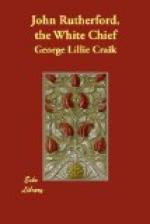She was at last, however, fairly exhausted; and stood, at the conclusion of the exhibition, Nicholas tells us, panting for breath. “In this state,” says he, “she was pleased to notice me with a distinguished mark of flattering condescension, by holding out her lips for me to kiss, an honour I could have very well dispensed with, but which, at the same time, I could not decline, without offering a slight to a person of such elevated consequence.”
He saw, also, some other female warriors, who exposed themselves in the combat with great gallantry. Among them, Marsden tells us, was the widow of Tippahee, a woman apparently not much less than seventy years of age.
Cook also sometimes saw the women armed with spears.
The principal native war-instrument of the New Zealanders is the short thick club, which has been so often mentioned. This weapon they all constantly wear, either fastened in their girdle or held in the right hand and attached by a string to the wrist. It is in shape somewhat like a battledore, varying from ten to eighteen inches in length, including a short handle, and generally about four or five broad, thick in the middle, but worked down to a very sharp edge on both sides. It is most commonly formed of a species of green talc, which appears to be found only in the southern island, and with regard to which the New Zealanders have many superstitious notions. Some of them are made of a darker-coloured stone, susceptible of a high polish; some of whalebone; and Nicholas mentions one, which he saw in the possession of Tippoui, brother of the celebrated George of Wangarooa, and himself one of the leaders of the attack on the ‘Boyd,’ which, like that of Shungie, which Rutherford speaks of, was of iron, and also highly polished. It had been fabricated by the chief himself, with tools of the most imperfect description; and yet was, in Nicholas’s opinion, as well-finished a piece of workmanship as could have been produced by any of our best mechanics. This instrument is employed in close combat, the head being generally the part aimed at; and one well-directed blow is quite enough to split the hardest skull. The name usually given to it, in the earlier accounts of New Zealand, is patoo-patoo. Anderson, in his general remarks on the people of Queen Charlotte Sound, says it is also called Emeeta. But its correct and distinctive name seems to be that by which Rutherford always designates it, the mery or mairy.
[Illustration: Christchurch Museum
1. Pou-wherma. 2. Taiaha of white whale-bone. 3. Taiaha (6ft. 3in. long) of wood, with flax mat and dog’s hair. 4. Hoeroa of white whale-bone. 5. Tewha-tewha.]
Savage tells us that when he took his friend, Moyhanger,[CM] to a shop in the Strand to purchase some tools, he was particularly struck with a common bill-hook, upon which he cast his eyes, as appearing to be a most admirable instrument of slaughter; and we find accordingly that since they have had so much intercourse with Europeans some of the New Zealand warriors have substituted the English bill-hook for their native battle-axe. Nicholas mentions one with which Duaterra was accustomed to arm himself.




